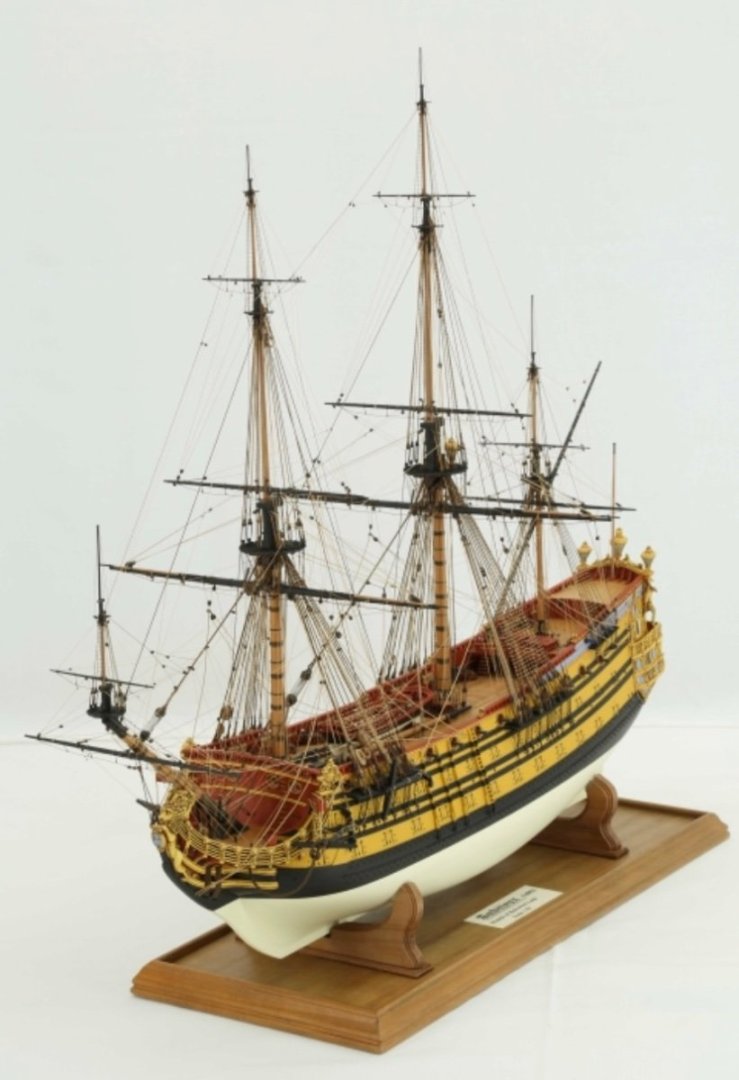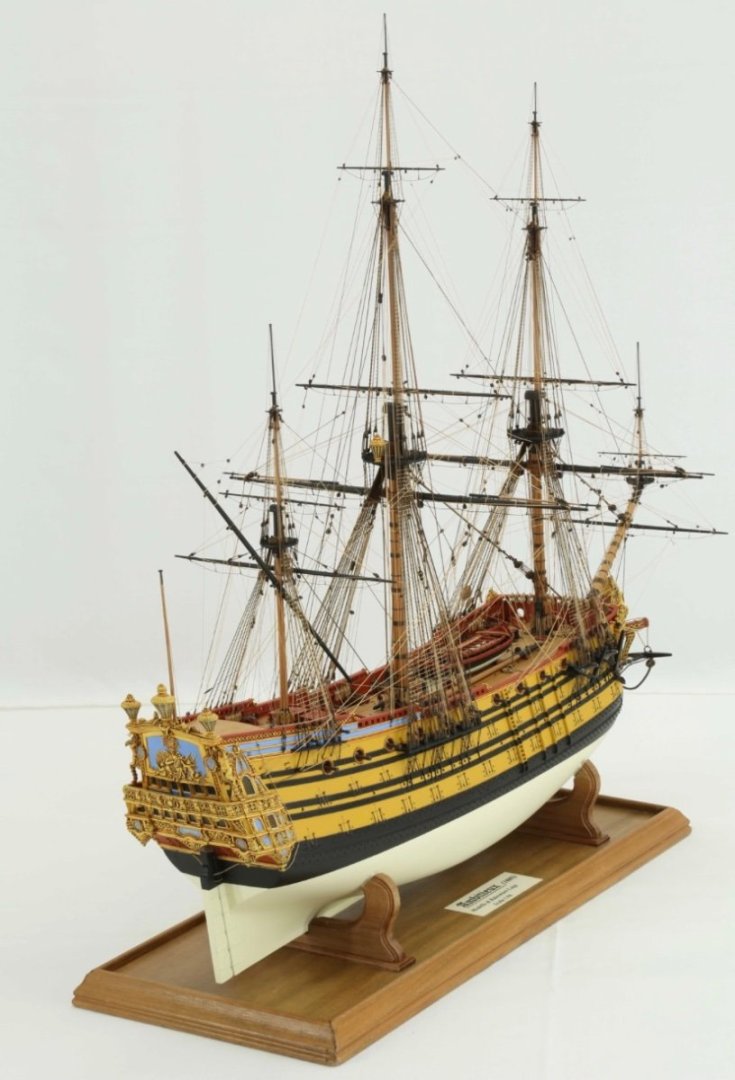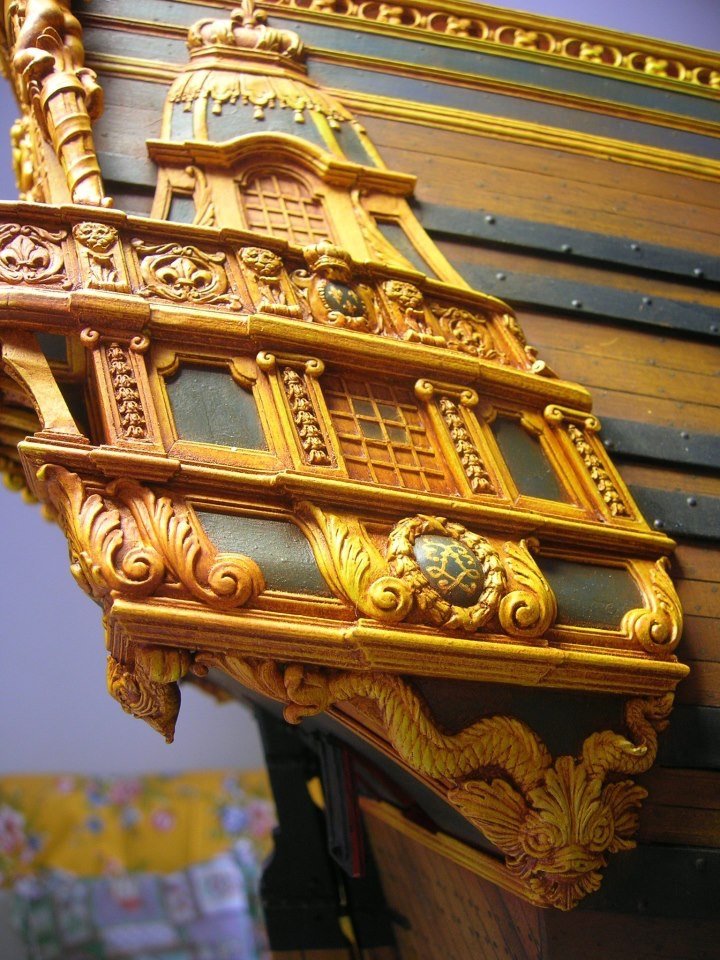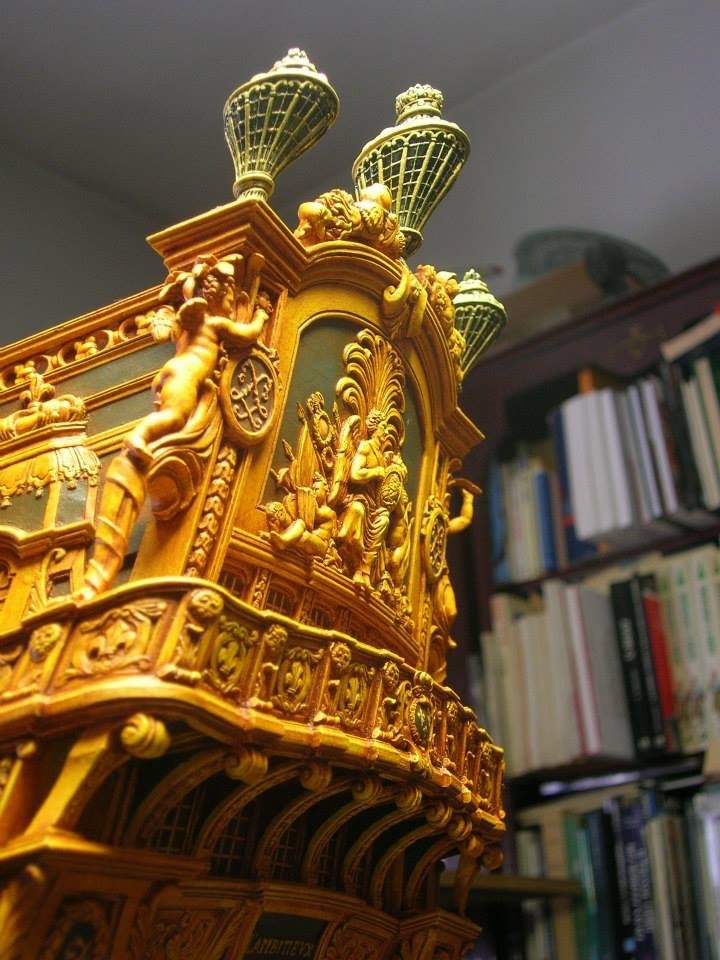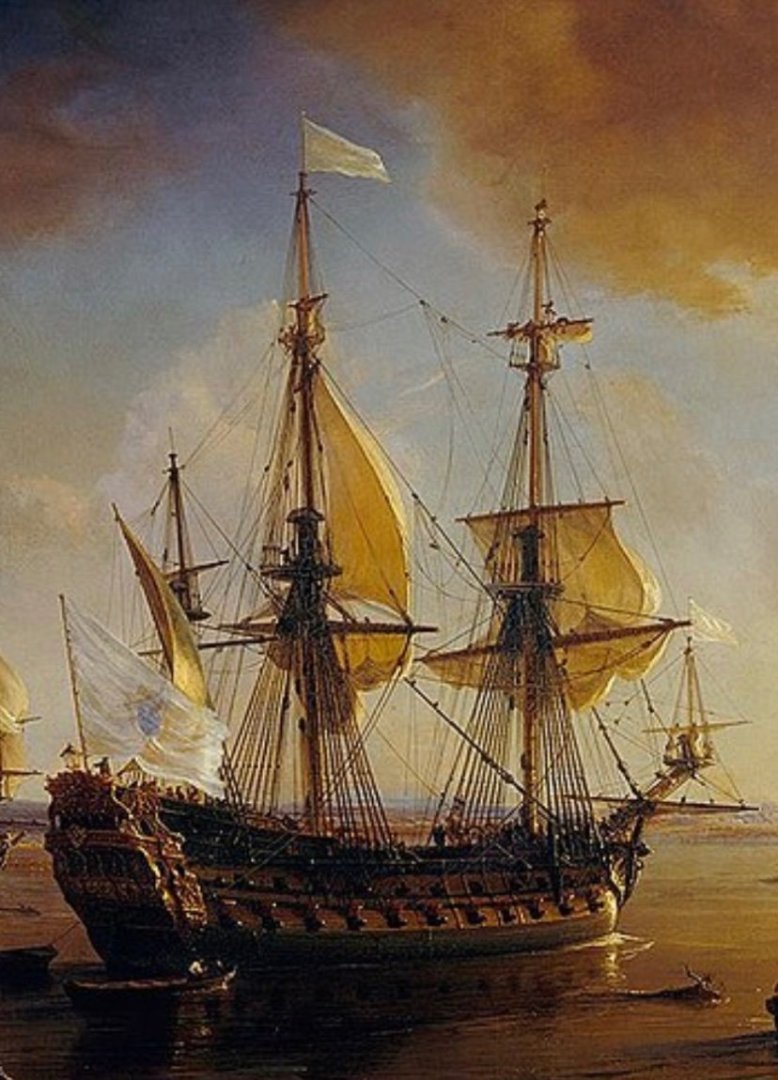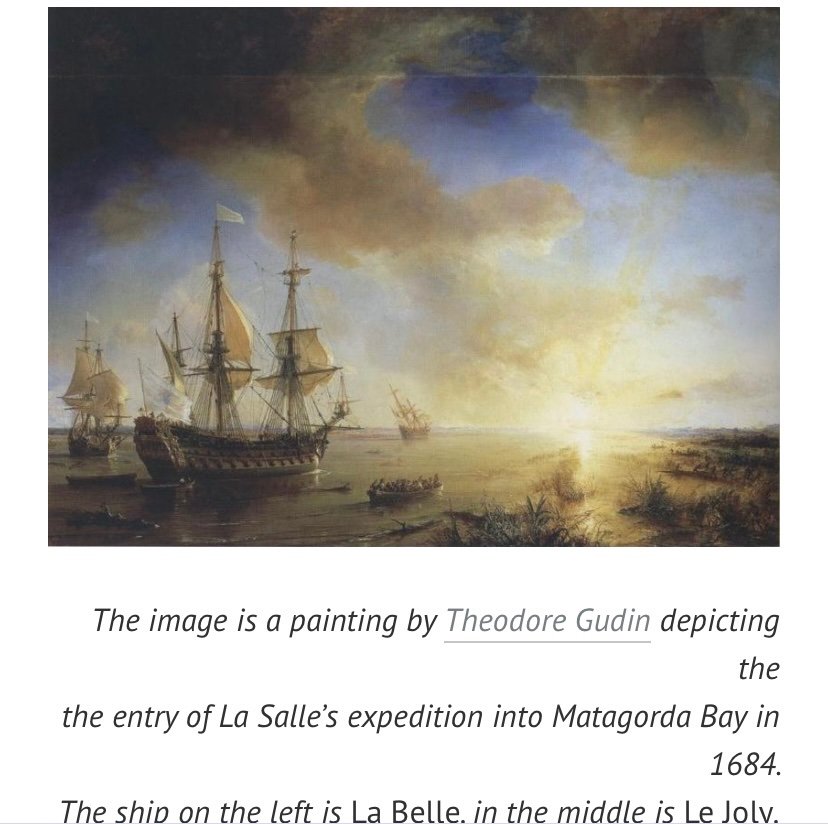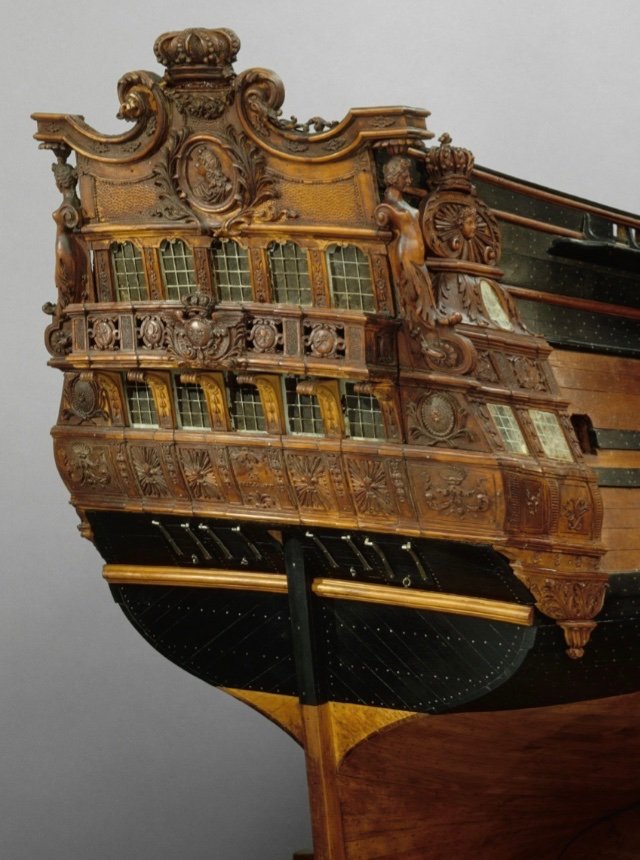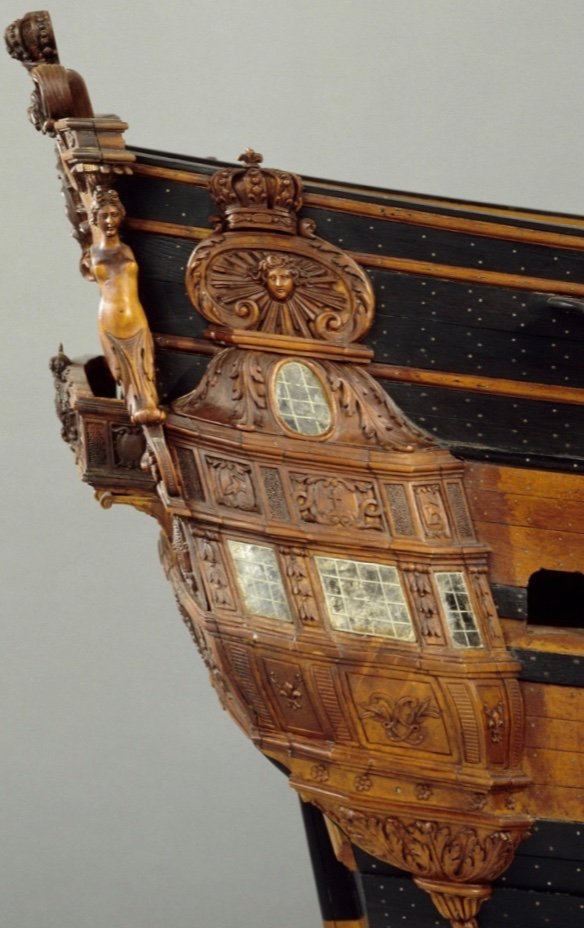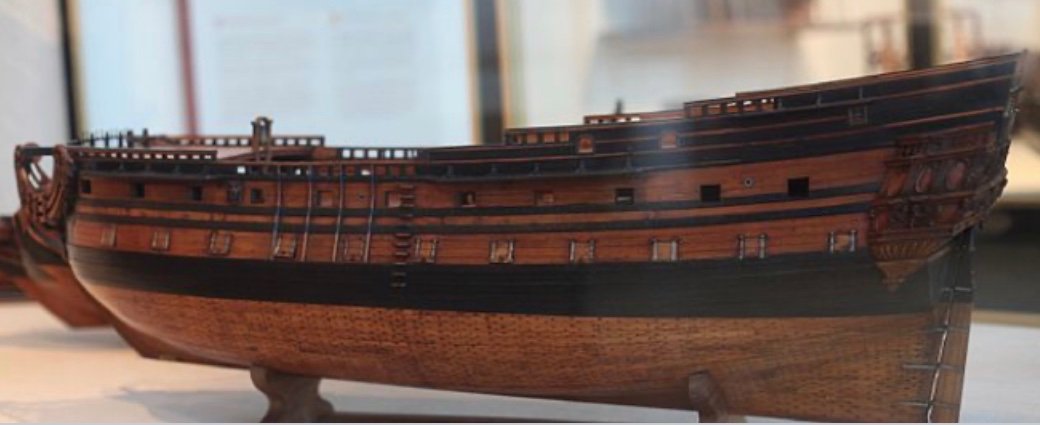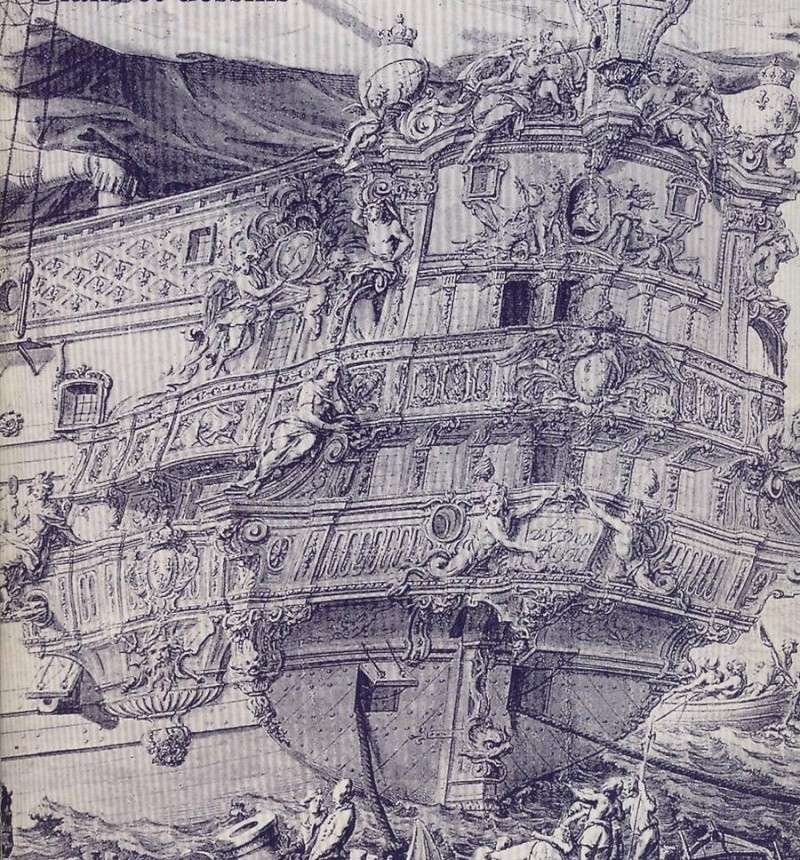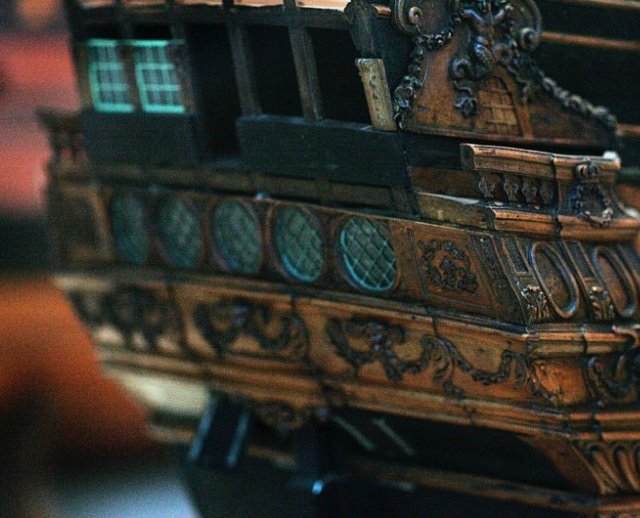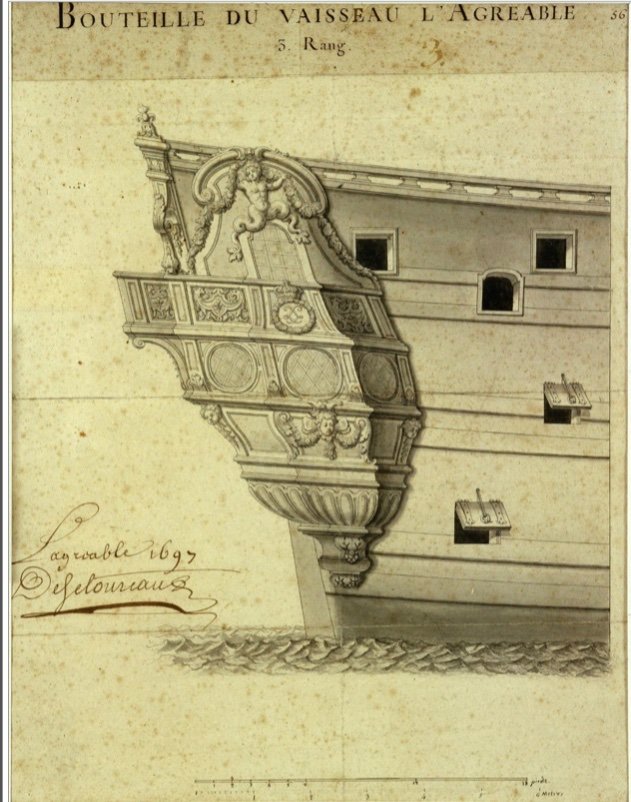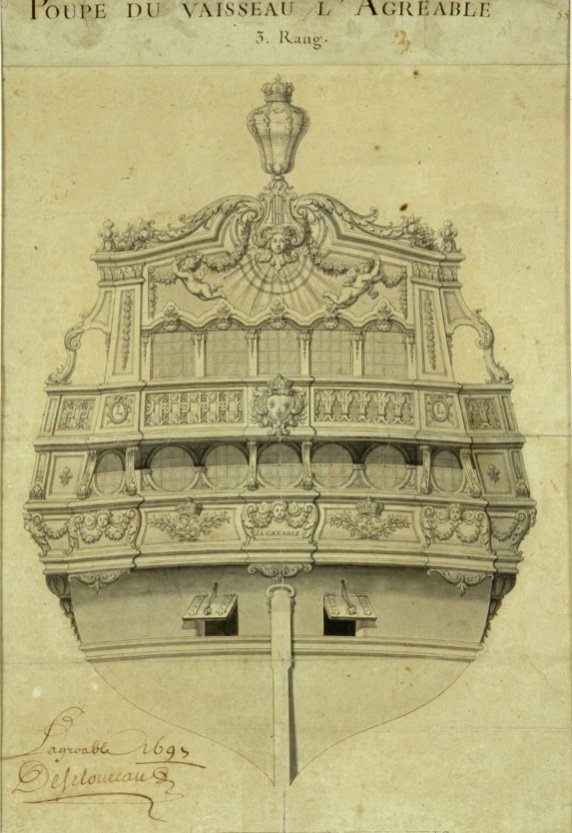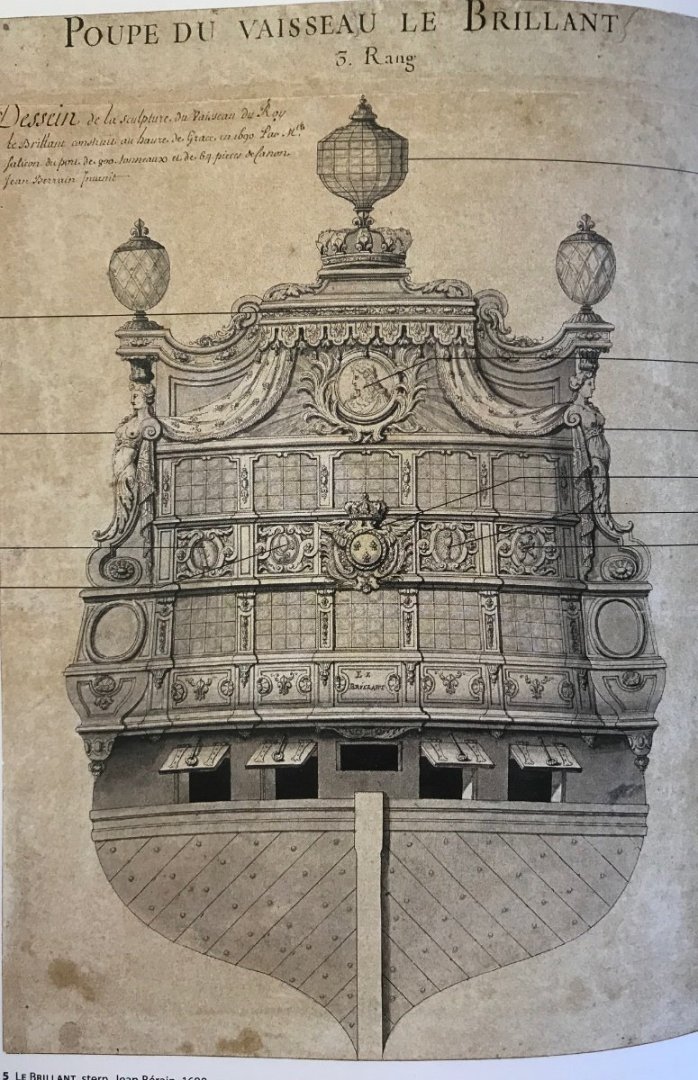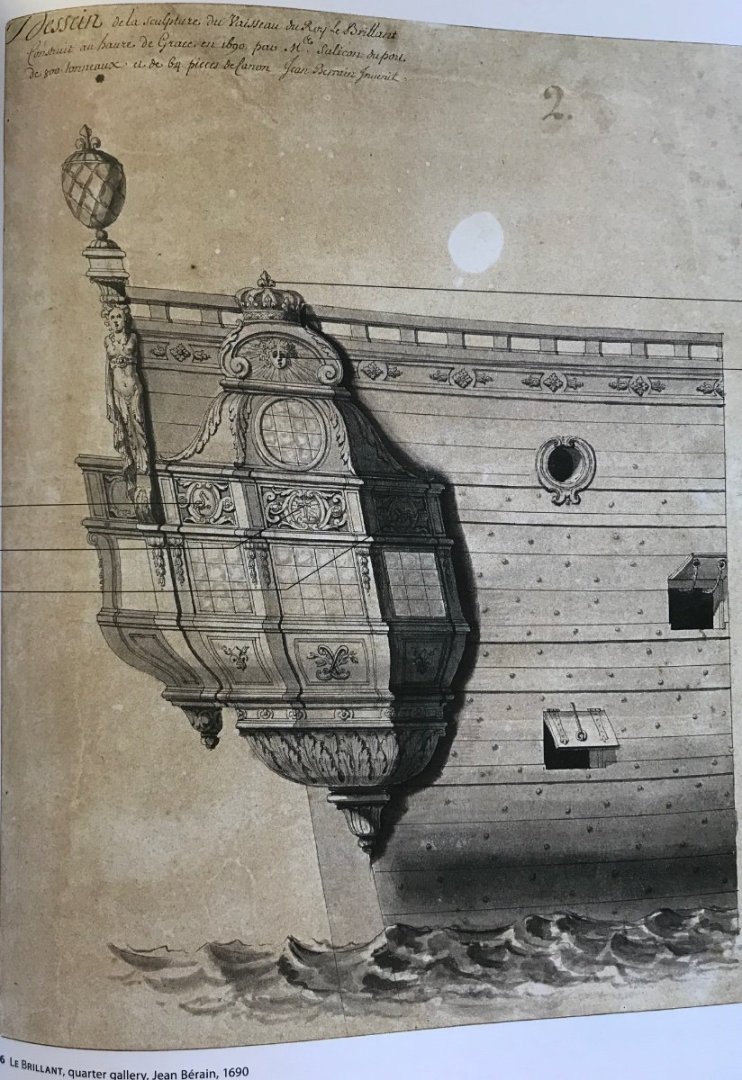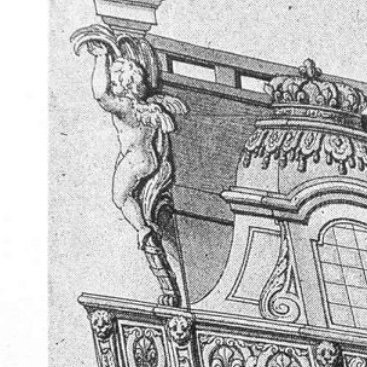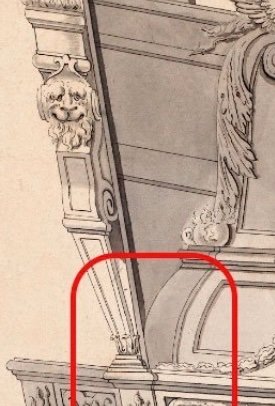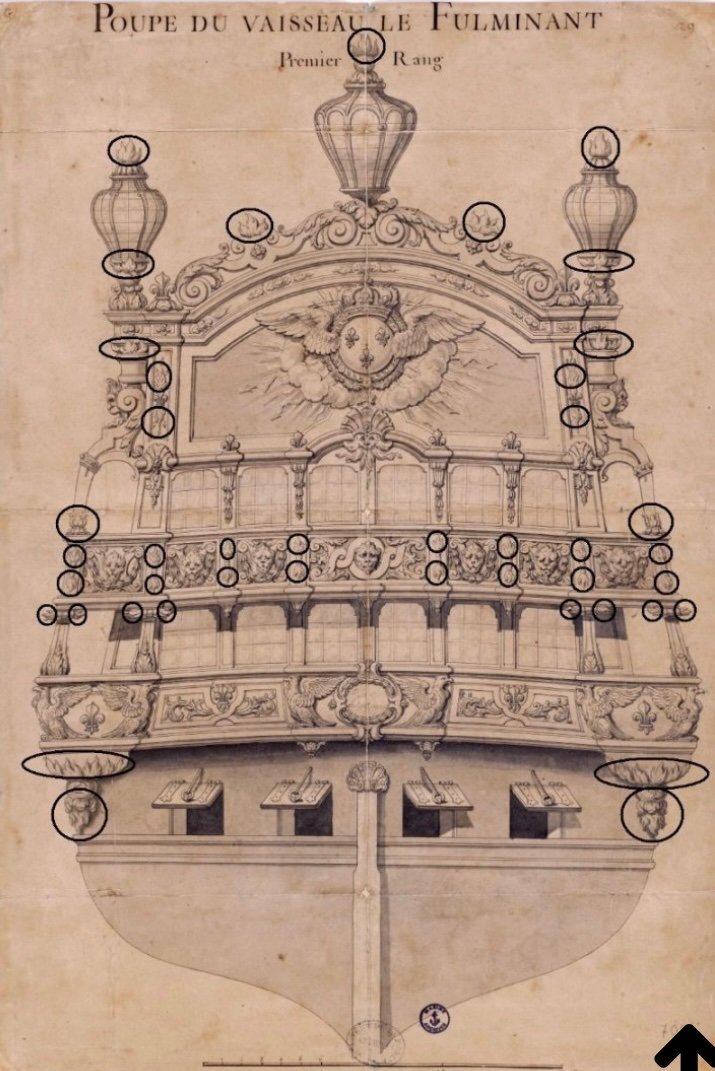-
Posts
3,305 -
Joined
-
Last visited
Content Type
Profiles
Forums
Gallery
Events
Everything posted by Hubac's Historian
-
The rig all looks neat and taught, Bill!
- 1,508 replies
-
- Le Soleil Royal
- Heller
-
(and 1 more)
Tagged with:
-
Correct, they are both full three deckers, and were classified as First-Rates. When these ships were first constructed in the 1690’s, they were overloaded with the number of guns in such a way that adversely affected their handling, and subsequently their armament was reduced. When I say that they are the origin point for the 74, what I mean is that this was the first attempt to really standardize efficient fire-power and handling. Ultimately, this tendency culminates in the 74, but there would certainly have been more direct corollaries in the 18th Century.
-
I also want to say that your connection of Versailles to the coloration and architecture of SR’s stern is right-on. For years, I puzzled over just what all of these different color choices were actually trying to represent. I thought the bronze sculptures were maybe to indicate ornamental carvings that were preserved from before the refit. With your parallel color examples to art within Versailles, you have made the probable intent very clear.
- 106 replies
-
- Soleil Royal
- Ship-of-the-line
-
(and 2 more)
Tagged with:
-
John, I have not been challenged to look up so many vocab words since my father was still in his right mind. Apocryphal was on my “frontier” of near-understanding, but epipelagic is a new one for me. I take you to mean something like “keep on truckin!,” but in the water. Keep on swimmin!, maybe? As always, I really love your succinct and well-researched info-graphics. Your historic colorist analysis is the best discussion of 17th Century blues that I have yet seen. As you noted, and have now given me artistic vocabulary to describe it, I chose to paint in the Mannerist style, although not because I was well-versed in the art history of it. Broadly, I reasoned that if the early Baroque Vasa could be painted so, why mightn’t the later Soleil Royal also be painted so - particularly, when there was a mandate to reduce the use of expensive gold; a broader color palate could be used to highlight the ornamental program. Mostly, for me, that was an artistic choice, but I REALLY appreciate the window of plausible deniability that you have opened for me, in referencing the potential preferences of the Dutch-trained Laurent Hubac. His early ships were broad like Dutch ships, fitted with very Dutchy head structures, tall-sheered like Dutch ships, and very boxy in the stern. As intransigent a constructor as he was, perhaps he also insisted on a more Dutchy color scheme. Thank you for that! I think, though, that the scheme you have chosen for your model hews much more closely to the probable truth of the matter, especially toward the end of the century, as the French were moving towards uniform classifications and construction specs for the rates. What you have managed to do so beautifully, is to create tremendous visual interest with the color variations between decks, and in the painting of all supporting ornamental mouldings and panels. Your demonstration of what faux gold might look like is absolutely convincing to me. I’m loving the log so far!
- 106 replies
-
- Soleil Royal
- Ship-of-the-line
-
(and 2 more)
Tagged with:
-
Also, Henry - what a trip! Congrats on your anniversary! How many years?
- 1,508 replies
-
- Le Soleil Royal
- Heller
-
(and 1 more)
Tagged with:
-
Ahhh, I was not aware of 4H. I did an image search and pulled that extract from Souvenirs from the first site I found. That is the cardinal rule around here, so I will delete the post. It served its purpose for the discussion, anyway.
- 1,508 replies
-
- Le Soleil Royal
- Heller
-
(and 1 more)
Tagged with:
-
Yeah, I would definitely trim the back end, as well. I had the benefit of building this kit before. Over time, the issue of these trestle trees began to bother me. You can monimize this problem, though. Fortunately the t’gallant trees are in scale.
- 1,508 replies
-
- Le Soleil Royal
- Heller
-
(and 1 more)
Tagged with:
-
If you shorten each side of each cross-piece, by say a generous 1/16”, then that would bring the deadeyes that much closer to the mast centerline, which would make them appear less spread-out over a span that is roughly half that of the topmasts.
- 1,508 replies
-
- Le Soleil Royal
- Heller
-
(and 1 more)
Tagged with:
-
With the shroud spread, it should taper to less and less as you go up the mast. This is the main reason that I widened my main tops.
- 1,508 replies
-
- Le Soleil Royal
- Heller
-
(and 1 more)
Tagged with:
-
My advice, as far as scale of the mast sections would be to mock it up with dowels and see what it actually looks like with different height t’gallants. It would also be a good idea to mock up your sail plan, relative to these heights. The t’gallant yards, BTW, are also too long. Yes, you are measuring from the foot of the t’gallant to the underside of the flagstaff cap. Now, while you have followed the kit instructions for the topmast tops to the letter, Heller’s tops are more mid-18th Century, in style, and grossly out of scale - far too wide. If you are shortening the t’gallants, then the spread of the t’gallant shrouds will look really wrong, as compared with the spread of the topmast shrouds below. On the stock kit, without any modifications, the spread already looks wrong. My solution, here, would be to shorten the ends of the crosstrees, on each side, to reduce the spread. My plan is to remake these trestletrees from scratch. However, if that idea does not appeal to you, at this stage, I would simply keep the t’gallants the height that they are, and correct the t’gallant yard length, so that at least the sail-plan looks more right than wrong. Compare Heller’s masting to this scratch-built 1:96 of L’Ambiteaux: There are significant differences in scale, there.
- 1,508 replies
-
- Le Soleil Royal
- Heller
-
(and 1 more)
Tagged with:
-
If you went with the slightly smaller ratio of .4:1, then the t’gallant would be 3 5/8”, up to beneath the mast cap.
- 1,508 replies
-
- Le Soleil Royal
- Heller
-
(and 1 more)
Tagged with:
-
No problem, Ian, now it’s my turn. Yeah, thanks for clarifying this. Since I have no lower hull, and the Heller depth of hull would be wrong, anyway, I am only concerning myself with what can be seen above the main deck. ‘Definitely cheating, here!
- 1,508 replies
-
- Le Soleil Royal
- Heller
-
(and 1 more)
Tagged with:
-
Don’t quote me on this, but in actual practice everything is derived, proportionally, from the lower main mast. I’m taking the easy way out and just figuring out relative proportions for each mast, based on each’s lower mast section, according to what I see on the SP plans. And, I’m doing that, also in-part, because I chose to use the lower mast sections of the kit, despite what are sure to be various proportional inaccuracies, i.e. the length of the cheeks, as well as certain detail discrepancies like the longitudinal stiffeners that run along the sides of the mast. I’m not sure what those are called, but they wouldn’t be present at this time. If I were making everything from scratch, I’d follow all of the rules, but since I’m making what is in many ways and impressionistic model, based on my observations of contemporary artwork, I am more concerned with the overall impression of scale.
- 1,508 replies
-
- Le Soleil Royal
- Heller
-
(and 1 more)
Tagged with:
-
Hi Bill - last week, I was referencing the St. Philippe monograph plan in 1:96, to begin figuring out what line diameters I needed, and the deadeye dimensions, and so forth. Then, I realized that because I want my masting to proportionally resemble that of the SP monograph. I could simply figure out what the relative proportion of the main topmast (from topmast heel to just beneath topmast cap) was to the lower main mast (from main deck level to just beneath mast cap), and then apply those proportions to my topmast. For the t’gallant, I could apply the same process, relative to the topmast length. Now, I don’t have this in front of me, right now, but my recollection is that my main mast rose 10” above the main deck to just below the mast cap. For a sense of proportion, that is about 5/8” more than what is shown on the 1:96 SP plans. That is okay, as far as I’m concerned. I raised my main mast height early in the process, back when I thought I would copy the kit topmast lengths. This idea for a proportional rig only just occurred to me. Again, it isn’t in front of me, but the SP topmasts work out to something like .825 of the main mast height above deck level. Applying that proportion to what will be my scratch made topmasts, I come up with something like an 8 1/4” topmast. Applying the same logic, the t’gallant height is something more than half the height of the topmast below. I don’t remember the exact figure. Overall, my rig will probably seem a little taller than it should, but I have also extended the overall length of the hull by 1/2”, so maybe it won’t be too noticeable. It is more important, given this compromise, that the mast sections at least be proportional to each other because that is what makes them functionally able to be lowered and removed.
- 1,508 replies
-
- Le Soleil Royal
- Heller
-
(and 1 more)
Tagged with:
-
This is always, IMO, the difficulty of interpreting Berain drawings - even among known sets of drawings that are signed and dated by the arsenal intendant of the time, e.g. Desclouszeaux circa 1690s, there are often weird incongruities between the stern and quarter view; the stern or quarter drawing may not always support the logic of the one or the other. More on that in a minute. I agree that your observations of the shading along the forward edge of the upper quarter gallery, as well as the oddly broken plane of the quarter deck window, would seem to indicate a fully closed quarter gallery. However, I will do my best to articulate why I think the quarter gallery upper finishing is actually a shallow trompe l’oeil amortisement. When it comes to Berain drawings, one conceit of his style appears to be that when he draws the stern view - whatever details of the quarters that may still be visible from the stern, in real life, are simply not included. Let’s begin by looking at your work-up of Le Fulminant’s stern: Focus first on the lower tier of lights. At the corners, where the stern wraps around to the quarters, this is shown as completely open. In reality, though, this lower corner is the functional seat of ease; there would certainly be a false window panel, integral to the quarter gallery and visible from the stern. This whole lower level of the quarter galleries would be enclosed with false lights. Now, look at the upper tier of lights, where the stern wraps to the corners. There is what appears to be an open, pass-through archway. Whether the design intent be a trompe l’oeil amortisement - which, in reality, would still be visible through this stern archway - or a fully rounded upper finishing, Berain has not drawn any representation of either. Consider, now the stern and quarter view for Le Brillant of 1690: Here, it is a somewhat different story. On the lower wrapping corner, there is an oval frame for a shaded blank panel, concealing the functional toilet. On the upper wrapping corner - rather than a pass-through archway, there is a scrolled buttressing bracket that clearly delineates the boundaries of the upper stern balcony as being within the five lights of the stern, as opposed to wrapping to the quarter galleries. The quarter view confirms this interpretation. Interestingly, though, Berain’s quarter view of Le Brillant appears to show an open and walkable stern balcony at the counter level. This simply would not have been the case, at this later stage in the development of stern architecture. By the 1680s, these fragile structures, which were vulnerable to following seas, were done away with completely. The stern counter facade, on the other hand, continued to be decorated with pilasters and reliefs that were consistent with the balcony decor on the levels above; it became, in other words, a kind of shallow “false” balcony to support only carved figures or brackets. I believe that Tanneron’s model of Le Brillant interprets this architecture correctly: Although, it must be noted that Tanneron makes interesting departures from the drawing, with his interpretation of the big carving below the tafferal. Next, consider the drawing set for L’Agreable: Again, we see the open archway at the top corner. Interestingly, the balcony overhang shadows do not continue to the quarters, which would seem to indicate that the balcony only extends to the ship sides, as opposed to wrapping around to the corners. The quarter view seems to confirm this as the side of the upper balcony is noticeably shaded, as though set-in from the sides of the quarters. If the upper finishing of this quarter gallery is fully rounded, it seems to me like an awkward transition, beginning at the balcony level caprail and diminishing at the sheer rail. Perhaps Tanneron thought the same and preferred to represent the upper finishing as a Tromp L’oeil amortisement: The model is damaged, but Tanneron’s intent of a wrapping and walkable balcony through the now missing pass-through arch is clear. This interpretation is consistent with that of Tanneron’s contemporary, the Court Marine painter (1830’s), Theodore Gudin. Here is a famous painting of the LaSalle expedition of 1684, featuring a consort warship, Le Joli, of the same class as Le Brillant and L’Agreable: The structure of the quarters and stern is very close to that of Tanneron’s L’Agreable. It is impossible to know exactly what sources were available to these two artists, who were recording structures from 145, or so, years prior, but their agreement on the matter must carry some weight, IMO. One last example comes from a slightly earlier time, and from a rigorously detailed artist. Puget painted, below, not a proposal for decor, but the actual refit appearance of Le Dauphin Royal in the early 1680s: Here, the pass-through archway and wrapping upper balcony to a shallow amortisement upper finishing are plainly decipherable. Interestingly, the lower level of the quarter gallery is open on it’s sides - an artifact of the early First Marine (1670s) stern architecture, but closed-off from the stern view with buttressing brackets. I maintain that by the late 1680s, this level would have been completely closed up with false/removable lights. Another possible artifact of this earlier time may be a small “Juliet” balcony at the center of the stern counter. It is hard to know whether that is actually a place where someone can stand. Personally, I doubt it. With all that said, and considering the Fulminant drawings, in particular, I will draw your attention to two small details. Going back to the stern view: The upper balcony casts a shadow beneath that extends fully to the ship sides - a point beyond the shadow that would be cast if the balcony ends were actually located between the second and third lion mascaroons. This suggests that the balcony extends to the end of the quarters. Now, take a closer look at the archway for L’Ambiteaux: Notice the shading just visible beneath the pass-through archway. The same is present for Le Fulminant: Given the way that a fully-rounded upper finishing would scallop back towards the ship’s upper bulwarks, in the characteristically concave French Style, this would be a really weird and awkward transition, if one were to walk to the ends of that upper balcony and look through that open archway. It’s not impossible, but it would not be very coherent. The tromp l’oeil amortisement just makes more sense here. I think that Boudriot’s monograph interprets this correctly.
-
After seeing your Victory, Ian, I will be very excited to see what you do with this kit.
- 106 replies
-
- Soleil Royal
- Ship-of-the-line
-
(and 2 more)
Tagged with:
-
Awesome historical recap, John. The two best books in my library are both Rif Winfield books: French Warships, as you reference, and First Rate. I do think it is probable that the ship was repaired after Beveziers and her ornamental program completed (I have repair estimates from the archives, after the fleet’s return to port), before Barfleur in 1692. However, like most other things related to SR, there are no concrete records detailing the specifics of this. The screen shots I have of these repair estimates are barely legible. I will have to remember “Harbor Queen,” as I design my conjectural 1670 SR. It’s hard for me not to imagine the members of ABBA as Admiral and supporting officers 😀
- 106 replies
-
- Soleil Royal
- Ship-of-the-line
-
(and 2 more)
Tagged with:
-
Where did you source 3.5 MM from? I’ve been referencing the St. Philippe monograph because, included among the plates is a sail and rig plan in 1:96. According to that schematic, 5MM (3/16”) is appropriate for the lower main and fore deadeyes. The trick is finding a good balance of scale graduation for everything else. On the monograph plans, the spritsail and mizzen top deadeyes are impossibly small - as you noted earlier in your log. 2.5 MM is the smallest size I can find. Forget about the t’gallant crosstree deadeyes, which look practically non-existant! I was thinking about 2.5 for the sprit, fore and main t’gallants, and the mizzen top. I could probably get away with 3 MM on the fore and main tops, as well as the backstays. Then maybe 3.5 on the mizzen shrouds. My annoyance is that the Amati deadeyes are not nearly as nice as the Dockyard Models version, but Dockyard doesn’t offer half sizes. Maybe I can do a little dressing of the Amatti product to make them look more like Dockyard.
- 1,508 replies
-
- Le Soleil Royal
- Heller
-
(and 1 more)
Tagged with:
-
Bill, your lower deadeyes are 5 MM, correct? And 3 MM for the fore and main tops?
- 1,508 replies
-
- Le Soleil Royal
- Heller
-
(and 1 more)
Tagged with:
About us
Modelshipworld - Advancing Ship Modeling through Research
SSL Secured
Your security is important for us so this Website is SSL-Secured
NRG Mailing Address
Nautical Research Guild
237 South Lincoln Street
Westmont IL, 60559-1917
Model Ship World ® and the MSW logo are Registered Trademarks, and belong to the Nautical Research Guild (United States Patent and Trademark Office: No. 6,929,264 & No. 6,929,274, registered Dec. 20, 2022)
Helpful Links
About the NRG
If you enjoy building ship models that are historically accurate as well as beautiful, then The Nautical Research Guild (NRG) is just right for you.
The Guild is a non-profit educational organization whose mission is to “Advance Ship Modeling Through Research”. We provide support to our members in their efforts to raise the quality of their model ships.
The Nautical Research Guild has published our world-renowned quarterly magazine, The Nautical Research Journal, since 1955. The pages of the Journal are full of articles by accomplished ship modelers who show you how they create those exquisite details on their models, and by maritime historians who show you the correct details to build. The Journal is available in both print and digital editions. Go to the NRG web site (www.thenrg.org) to download a complimentary digital copy of the Journal. The NRG also publishes plan sets, books and compilations of back issues of the Journal and the former Ships in Scale and Model Ship Builder magazines.




